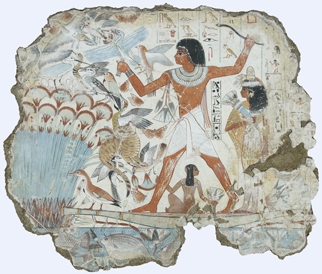Week 4 Nebamun the man and his tomb
Introduction
In this section you will explore who Nebamun was and what we know about him, as well as how we know what we know.
When talking about ancient civilisations – inspired by the hundreds and thousands of books that have appeared on the subject, not to mention films and television programmes that confidently tell stories about Greeks and Romans, Chinese and Vikings, as well as ancient Egyptians – it is instructive to try and tell the story of an individual such as Nebamun.
The paintings from Nebamun's tomb-chapel are internationally renowned (Figure 1). They are among the most remarkable works of art to survive from the ancient world. They make that world seem vivid and immediate to us: the herd of cattle jostling their handlers, bellowing and stirring up the dust, the geese squawking in their boxes, Nebamun's cat flushing out birds among the reeds in the Nile marshes and sending up a cloud of coloured butterflies, his wife in her beautiful dress with immaculate hair and jewellery. We can imagine something of that life because of the apparent spontaneity of the images, very much as we can imagine the life going on in a scene of boating or dancing in nineteenth-century Paris in a painting by Renoir or Degas. But this is the power of pictures. The truth is that we know next to nothing about Nebamun. Or rather, all we know about him is contained in those paintings and their related texts.

